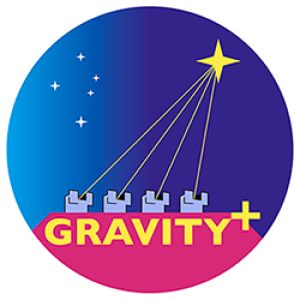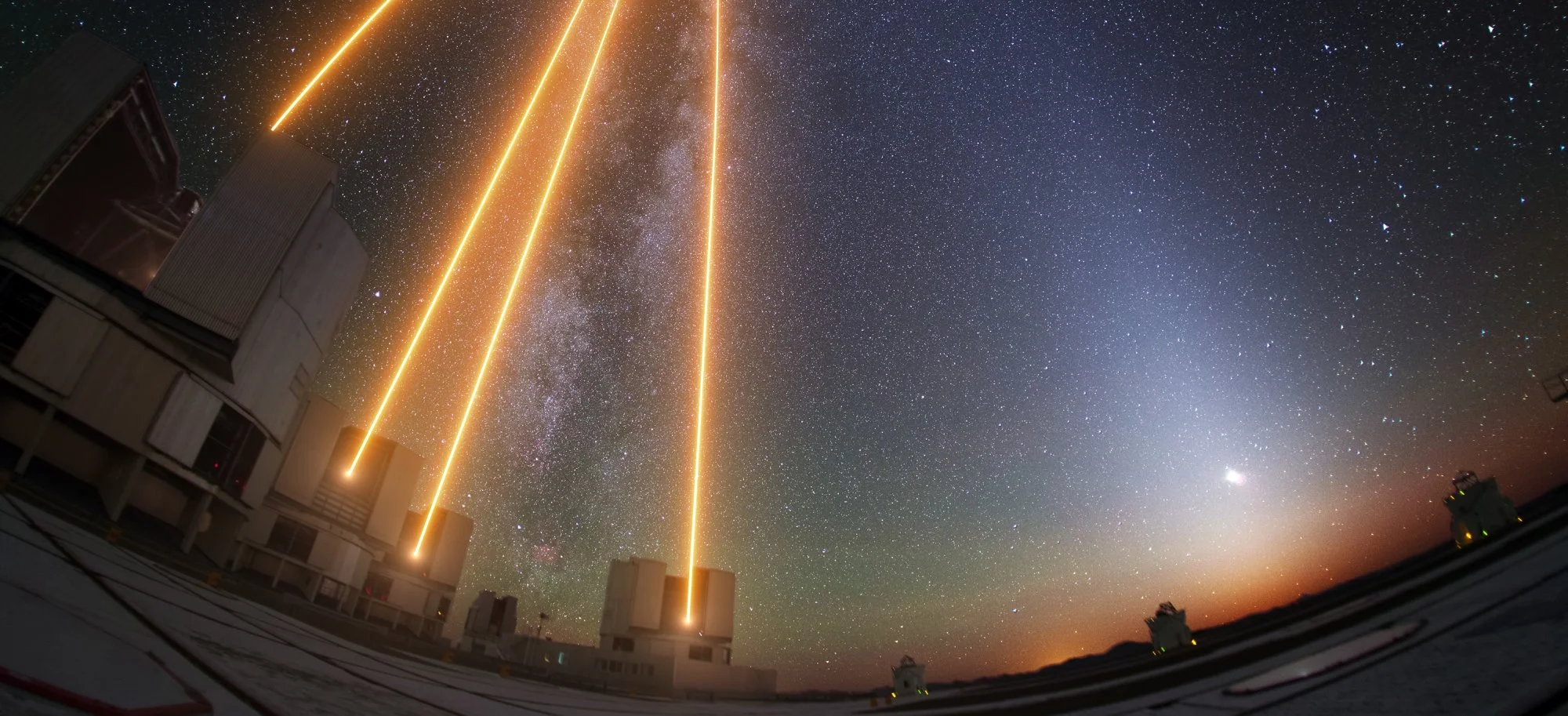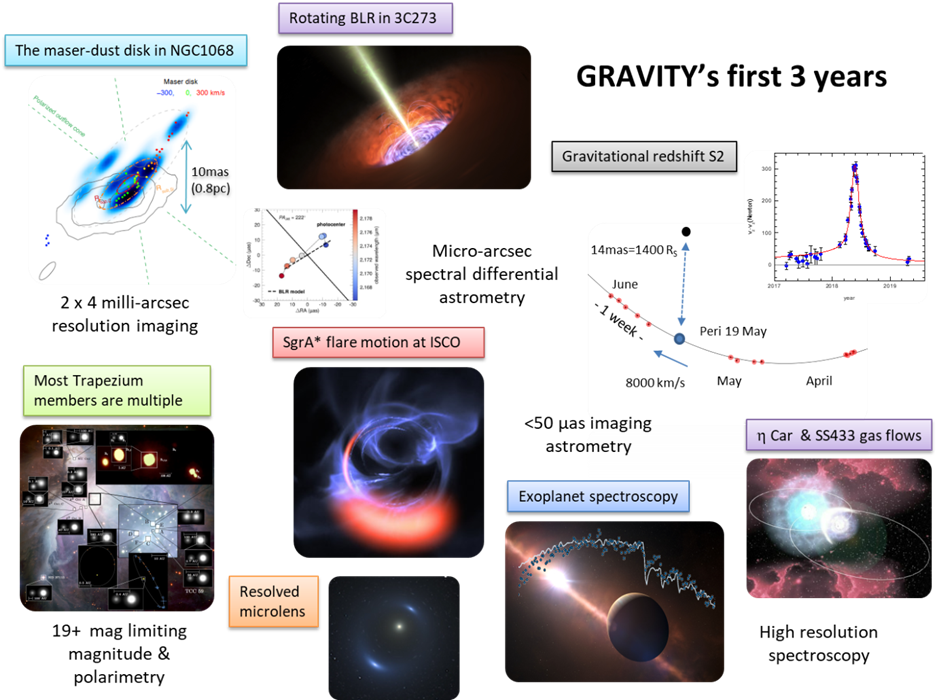Since its installation in 2016 on the Very Large Telescope Interferometer at the European Southern Observatory (VLTI/ESO), the GRAVITY instrument has produced spectacular and transformative results on the supermassive black hole at the centre of the Milky Way, the active nuclei of other galaxies, the proto-planetary disks around young stars and exoplanets. These results played a central role in the award of the Nobel Prize in Physics 2020 to three researchers : Roger Penrose, Andrea Ghez and Reinhard Genzel.
GRAVITY+ aims to modernise both the VLTI and GRAVITY to make them ≈ 100 times more sensitive, which is a major step forward, particularly for the study of the galactic centre. It also aims to increase sky coverage by a factor of ≈ 100 (which is critical for extragalactic astronomy) and contrast in the vicinity of bright objects by a factor of ≈ 10 (which is critical for characterising exoplanets). These gains will benefit all the VLTI’s current and future instruments for the next 20 years, and will perpetuate it as a unique infrastructure in the world. This is nothing less than fulfilling the initial vision of the VLTI’s designers, including Pierre Léna and Antoine Labeyrie, back in the 1980s.
GRAVITY successes
Since 2017, the VLTI/GRAVITY second-generation interferometric instrument has produced results of transformative influence. They have been the source of 79 rank A publications listed by the ESO bibliographic database. 50% of these are co-authored by the GRAVITY collaboration and cover a wide range of fields :
- study of the Galactic Centre : in-depth tests of general relativity and the central black hole paradigm (see above, thumbnails top right and centre) ; direct measurement of the distance to the Galactic Centre with an accuracy of 0.33%, a result that was a major contribution to the 2020 Nobel Prize in Physics ;
- Study of active galaxy nuclei (AGN) : size (0.1 pc), measurement of the turbulence and rotation of the Broad Line Region (BLR) of the type 1 quasar named 3C 273. Estimation of the mass of its central black hole with a precision of 40% (above, upper middle thumbnail) ; mapping of the hot dust of the spiral galaxy NGC1068, which does not conform to the unified model (above, upper left thumbnail) ;
- study of exoplanets] : first interferometric detection, measurement of the spectra of two hot exo-Jupiters with a factor of 10 improvement in the signal-to-noise ratio compared with previous measurements obtained by coronagraphic integral field spectroscopy. Determination of highly accurate exoplanetary orbits and atmospheric properties, and the first direct confirmation of an exoplanet discovered using the radial velocity method (above, second thumbnail from bottom right) ;
- survey (systematic study) of a large number of young objects, multiplicity and spectro-imaging of massive stars (above, bottom left and right thumbnails), gravitational microlenses spatially resolved for the first time (above, bottom middle thumbnail), X-ray binaries, interstellar gas and dust.
GRAVITY+, the VLTI rejuvenation programme

GRAVITY+ consists of a series of time-phased improvements to VLTI and GRAVITY :
- Fringe tracking mode with large separation between the reference star and the science source (GRAVITY Wide), in service since 2022 ;
- Improved performance of GRAVITY’s fringe tracker (in service since 2022) ;
- Improving GRAVITY’s performance on weak sources (GRAVITY faint)
- VLTI vibration control
- Deployment of new Extreme Adaptive Optics (XAO) for each 8-metre unit telescope (UT) of the VLT (Gravity+ Adaptive Optics, GPAO), which will make up the bulk of the French contribution (first light in 2024). These adaptive optics will eventually have four modes : operation on a natural reference star only (NGS) or on a natural star and a laser star (LGS), in both cases the natural star can be observed with a wavefront analyser operating in visible or infrared light ;
- Deployment of artificial stars to power these new adaptive optics (ESO contribution, delivery scheduled for the end of 2025).
A world-leading consortium
The GRAVITY+ consortium is made up of the Max Planck Institut MPE (PI Institute, Germany) and MPIA (Germany), CNRS/INSU (France), the University of Cologne (Germany), CENTRA (Portugal) and the University of Southampton (UK), in collaboration with ESO. CNRS/INSU is represented by all the French laboratories involved in VLTI : LIRA (Observatoire de Paris-PSL), IPAG (Observatoire de Grenoble), Lagrange (Observatoire de la Côte d’Azur), and CRAL (Observatoire de Lyon). GRAVITY+ is the first instrument to be built in collaboration between all 4 French interferometry groups, demonstrating the convergence of interests :
- The French partners are collectively responsible for the adaptive optics, GPAO
- LIRA is responsible for the real-time controller (RTC), coordinates the French contribution and is involved in improvements to the fringe tracker (FT) and data reduction software (DRS) ;
- Lagrange (OCA/Nice) is responsible for the integration and test bench (AIT-AIV) ;
- IPAG is responsible for the deformable mirror and its mount (DM), as well as the GPAO system ;
- CRAL is taking part in the development of the DRS and in the characterisation phases.
An ambitious schedule
GRAVITY+ was presented to ESO and the international community in June 2019. Following a competitive call organised by ESO, the consortium drafted a ‘white paper’ outlining the ambition and organisation of the project.
At its meeting on 7-8 December 2021, the ESO Council decided to move the instrument into phase B. At the national level, GRAVITY+ was placed in P0 by the French community as a ‘new instrumentation on existing infrastructures’ (Rapport de prospective en Astronomie Astrophysique 2019, INSU-AA). The project has rapidly passed through the design stages (phase A in 2021, preliminary and final GPAO design reviews in 2022) to enter its implementation phase.
The first GRAVITY+ XAO was being integrated in Nice in 2022. The second was also tested on a bench during 2023, rapidly followed by the other two at sub-system level in the institutes. The four complete systems were installed at Paranal in the summer of 2024, and the visible and infrared natural star modes (NGS and NGS_CIAO) were commissioned at the end of 2024. ESO will install the laser stars towards the end of 2025. The LGS and LGS_CIAO modes should therefore come into service at the beginning of 2026.
Banner image credits : ESO/Luis Calçada


